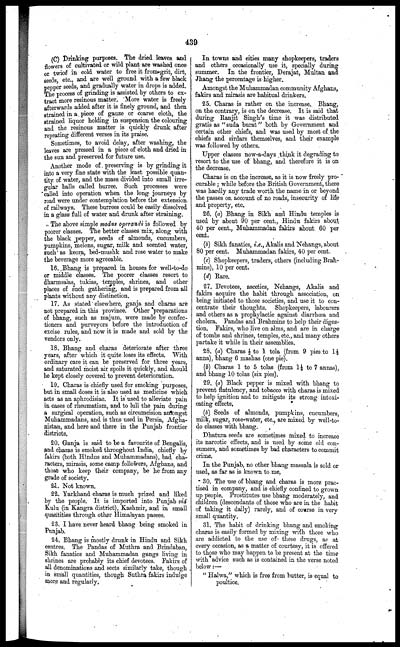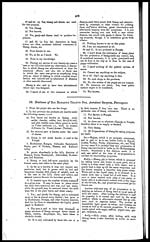Medicine - Drugs > Report of the Indian Hemp Drugs Commission, 1894-1895 > Volume V
(459) Page 439
Download files
Individual page:
Thumbnail gallery: Grid view | List view

439
(C) Drinking purposes. The dried leaves and
flowers of cultivated or wild plant are washed once
or twice in cold water to free it from grit, dirt,
seeds etc., and are well ground with a few black
pepper seeds, and gradually water in drops is added.
The process of grinding is assisted by others to ex-
tract more resinous matter. More water is freely
afterwards added after it is finely ground, and then
strained in a piece of gauze or coarse cloth, the
strained liquor holding in suspension the colouring
and the resinous matter is quickly drunk after
repeating different verses in its praise.
Sometimes, to avoid delay, after washing, the
leaves are pressed in a piece of cloth and dried in
the sun and preserved for future Use.
Another mode of preserving is by grinding it
into a very fine state with the least possible quan-
tity of water, and the mass divided into small irre-
gular balls called burree. Such processes were
called into operation when the long journeys by
road were under contemplation before the extension
of railways. These burrees could be easily dissolved
in a glass full of water and drunk after straining.
The above simple modus operandi is followed by
poorer classes. The better classes mix, along with
the black pepper, seeds of almonds, cucumbers,
pumpkins, melons, sugar, milk and scented water,
such as keora, bed-mushk and rose water to make
the beverage more agreeable.
16. Bhang is prepared in houses for well-to-do
or middle classes. The poorer classes resort to
dharmsalas, tukias, temples, shrines, and other
places of such gathering, and is prepared from all
plants without any distinction.
17. As stated elsewhere, ganja and charas are
not prepared in this province. Other preparations
of bhang, such as majum, were made by confec-
tioners and purveyors before the introduction of
excise rules, and now it is made and sold by the
vendors only.
18. Bhang and charas deteriorate after three
years, after which it quite loses its effects. With
ordinary care it can be preserved for three years,
and saturated moist air spoils it quickly, and should
be kept closely covered to prevent deterioration.
19. Charas is chiefly used for smoking purposes,
but in small doses it is also used as medicine which
acts as an aphrodisiac. It is used to alienate pain
in cases of rheumatism, and to lull the pain during
a surgical operation, such as circumcision amongst
Muhammadans, and is thus used in Persia, Afgha-
nistan, and here and there in the Punjab frontier
districts.
20. Ganja is said to be a favourite of Bengalis,
and charas is smoked throughout India, chiefly by
fakirs (both Hindus and Muhammadans), bad cha-
racters, mirasis, some camp followers, Afghans, and
those who keep their company, be he from any
grade of society.
21. Not known.
22. Yarkhand charas is much prized and liked
by the people. It is imported into Punjab via
Kulu (in Kangra district), Kashmir, and in small
quantities through other Himalayan passes.
23. I have never heard bhang being smoked in
Punjab.
24. Bhang is mostly drunk in Hindu and Sikh
centres. The Pandas of Muthra and Brindaban,
Sikh fanatics and Muhammadan gangs living in
shrines are probably its chief devotees. Fakirs of
all denominations and sects similarly take, though
in small quantities, though Suthra fakirs indulge
more and regularly.
In towns and cities many shopkeepers, traders
and others occasionally use it, specially during
summer. In the frontier, Derajat, Multan and
Jhang the percentage is higher.
Amongst the Muhammadan community Afghans,
fakirs and mirasis are habitual drinkers.
25. Charas is rather on the increase. Bhang,
on the contrary, is on the decrease. It is said that
during Ranjit Singh's time it was distributed
gratis as "suda burat" both by Government and
certain other chiefs, and was used by most of the
chiefs and sirdars themselves, and their example
was followed by others.
Upper classes now-a-days think it degrading to
resort to the use of bhang, and therefore it is on
the decrease.
Charas is on the increase, as it is now freely pro-
curable ; while before the British Government, there
was hardly any trade worth the name in or beyond
the passes on account of no roads, insecurity of life
and property, etc.
26. (a) Bhang in Sikh and Hindu temples is
used by about 90 per cent., Hindu fakirs about
40 per cent., Muhammadan fakirs about 60 per
cent.
(b) Sikh fanatics, i.e., Akalis and Nehangs, about
80 per cent. Muhammadan fakirs, 40 per cent.
(c) Shopkeepers, traders, others (including Brah-
mins), 10 per cent.
(d) Rare.
27. Devotees, ascetics, Nehangs, Akalis and
fakirs acquire the habit through association, on
being initiated to those societies, and use it to con-
centrate their thoughts. Shopkeepers, labourers
and others as a prophylactic against diarrhoea and
cholera. Pandas and Brahmins to help their diges-
tion. Fakirs, who live on alms, and are in charge
of tombs and shrines, temples, etc., and many others
partake it while in their assemblies.
28. (a) Charas ½ to 1 tola (from 9 pies to 1½
anna), bhang 6 mashas (one pie).
(b) Charas 1 to 5 tolas (from 1½ to 7 annas),
and bhang 10 tolas (six pies).
29. (a) Black pepper is mixed with bhang to
prevent flatulency, and tobacco with charas is mixed
to help ignition and to mitigate its strong intoxi-
cating effects,
(b) Seeds of almonds, pumpkins, cucumbers,
milk, sugar, rose-water, etc., are mixed by well-to-
do classes with bhang.
Dhatura seeds are sometimes mixed to increase
its narcotic effects, and is used by some old con-
sumers, and sometimes by bad characters to commit
crime.
In the Punjab, no other bhang massala is sold or
used, as far as is known to me.
30. The use of bhang and charas is more prac-
tised in company, and is chiefly confined to grown
up people. Prostitutes use bhang moderately, and
children (descendants of those who are in the habit
of taking it daily) rarely, and of course in very
small quantity.
31. The habit of drinking bhang and smoking
charas is easily formed by mixing with those who
are addicted to the use of these drugs, as at
every occasion, as a matter of courtesy, it is offered
to those who may happen to be present at the time
with advice such as is contained in the verse noted
below:—
" Halwa," which is free from butter, is equal to
poultice.
Set display mode to: Large image | Zoom image | Transcription
Images and transcriptions on this page, including medium image downloads, may be used under the Creative Commons Attribution 4.0 International Licence unless otherwise stated. ![]()
| India Papers > Medicine - Drugs > Report of the Indian Hemp Drugs Commission, 1894-1895 > Volume V > (459) Page 439 |
|---|
| Permanent URL | https://digital.nls.uk/75122225 |
|---|
| Description | Volume 5: Evidence of witnesses from North-Western Provinces and Oudh and Punjab. Answers from witnesses in North-Western Provinces, Oudh and Punjab about cultivation and growth of hemp, preparation or manufacture, trade, consumption or use, effects, administration - taxation and control. |
|---|---|
| Attribution and copyright: |
|




